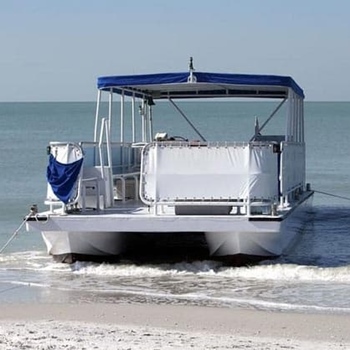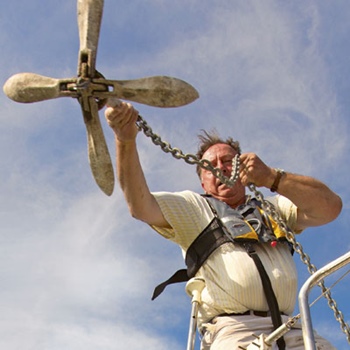Boating is pretty much like driving: it goes nice and smoothly until you actually have to part it – or, well, anchor it. Learning the proper way to anchor such a boat is a skill that every boating enthusiast needs to master. Otherwise, not only will they not be able to enjoy that experience to the max, but it might also cause accidents.
Why Safe Anchoring Is Important?
 Many times, when you go fishing, the chances are that you may not actually need the anchor – particularly when there is no wind and the waters are clear. However, if you end up with your pontoon boat in rough water, then you will need something to keep you secure and on the spot.
Many times, when you go fishing, the chances are that you may not actually need the anchor – particularly when there is no wind and the waters are clear. However, if you end up with your pontoon boat in rough water, then you will need something to keep you secure and on the spot.
That being said, while the theory might sound easy, it is not always as straightforward to anchor a boat. Ideally, you should practice in calm water – and once you have enough confidence, move towards other waters. With proper anchoring, you should be able to steer clear of a marine disaster.
Steps to Anchor a Pontoon Boat
Anchoring a pontoon boat is quite simple and only involves five steps. Here is what you need to do.
1. Choose a Good Spot
When you anchor your pontoon boat, you need to do it in a place that has been cleared of obstructions – including other boats. While it is not mandatory, it would be ideal if the boat faced the current or the wind.
You should also keep the area in mind. For example, if the area where you are anchoring it has a sandy, muddy, or rocky bottom, then you may need a different anchor (or multiple ones). Moreover, if there are any objects beneath the water that might compromise your position, then you might want to look into anchoring your boat somewhere else.
2. Choose the Right Length of the Line
To properly anchor your pontoon boat, you need to make sure that you calculate the anchor rope correctly. Ideally, the rope length should be multiple between 5-7 times the water depth. To this, you also need to add the distance between the waterline, along with the boat’s anchor point.
3. Get into the Spot
Once you determined a good spot and chose the line length, you need to maneuver the boat into the right position. Make sure that the bow is right ahead of the place where you want to drop your anchor. Once you get into position, stop the boat.
4. Drop the Anchor
Once you get yourself in position, slowly begin lowering the anchor of your boat into the water. It would not hurt to double-check that the anchor is efficiently secured to the boat; many people don’t notice and end up losing their anchors.
Also, refrain from just tossing or throwing the anchor into the water, like you see people do in the movies. It might look nice and fun, but all you will end up doing is fouling the line.
5. Set the Anchor
You might have lowered the anchor, and it might have touched the bottom of the water – but this does not mean it will keep the boat in one place. You will need to set the anchor now.
Pull the boat gently in reverse or allow it to go on a gentle drift; this will allow the anchor to dig into the waterbed – gradually putting a bit more tension on the line. You might want to maintain a moderate tension on it so that the line keeps straight – therefore, not dislodging your anchor from its spot.
Additional Anchoring Tips to Consider
 Anchoring your boat can be slightly tricky, which is why you may need as much advice as you can possibly get. Here are some tips that you may want to keep in mind:
Anchoring your boat can be slightly tricky, which is why you may need as much advice as you can possibly get. Here are some tips that you may want to keep in mind:
1. Choose the Right Weight
When choosing an anchor, you may want to make sure you select the right size in accordance to your boat. For instance, a 14 or 16-foot boat will need an anchor of at least 20 or 30 pounds to be properly secured. If it’s too lightweight, then your boat will not be able to remain properly anchored into the spot.
2. Consider Two Anchors
Sometimes, it is better to be safe than sorry. This is why, for your anchoring to be nice and secure, you may want to consider using two anchors rather than just one. An experienced boater will recommend that you drop one anchor off the bow and the second one from the stern. This will prevent the boat from swinging excessively, particularly when you are encountering bad weather.
Plus, if you have two anchors, you won’t have any worries that you won’t be able to anchor to a certain bottom type. You can get a generic anchor that can fit nicely with every bottom type, and you may get an anchor that is appropriate for the type of bottom that you typically anchor in.
3. Get a Heavier Anchor
While it’s not recommended to get a lightweight anchor, there’s nothing wrong with getting a heavier one. If your pontoon is rather lightweight, then you may be prone to drifting over the water. If you go for a heavier anchor, the extra weight will help you keep your boat into a proper position.
If you cannot get a new anchor, an alternative here would be to add a chain on your rope. This will add some extra weight to your actual anchor, making it a bit more secure.
Final Thoughts
As you can see, anchoring the boat is not at all difficult. Granted, it might take a bit of practice – but as you start exploring with your boat, it should come as second nature to you. Practice on calm waters first, and before long, you should have no issues anchoring your pontoon boat.